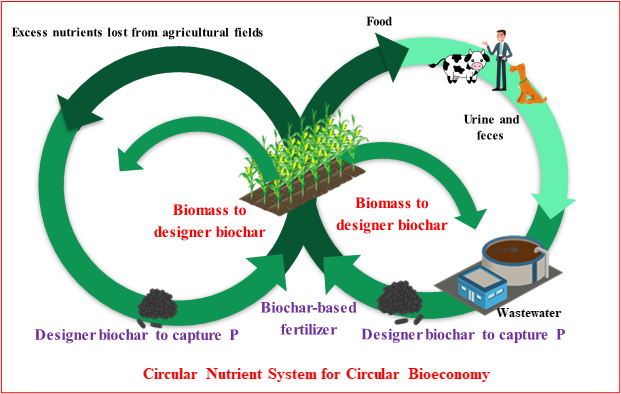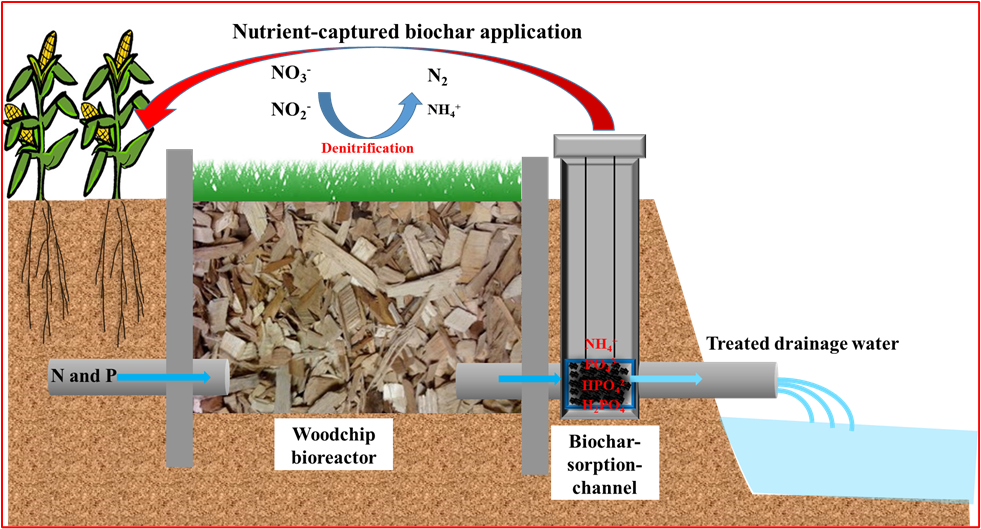Circular Nutrient System for Circular Bioeconomy
Macronutrients, such as nitrogen (N) and phosphorous (P), are critical growth-limiting nutrients for many crops. In general, plants uptake the nutrients applied in agricultural fields. Most of the nutrients in food crops pass through humans and animals and are excreted in urine and feces. If these wastes are not properly treated, the nutrients are often lost into the aquatic environment. However, nutrients are often applied in quantities that exceed crop requirements. These are released into surface water and groundwater through surface/subsurface runoff and leaching. Excess nutrients in watersheds can jeopardize water quality and trigger harmful algal blooms (HABs). There is an established scientific consensus that excess nutrients in marine and freshwater systems (e.g., the Great Lakes) are a primary cause of HABs. Therefore, it is critical to transition this linear process to a circular nutrient system, where nutrients are recovered to partially fulfill fertilizer demand and to prevent water pollution. Capturing nutrients from sewage or agricultural runoff is an essential step for the circular nutrient system.
Designer Biochar to Capture and Recycle Phosphorous from Tile Drainage Systems
To combat the excess phosphorus runoff problem, Wei Zheng of ISTC along with other colleagues from the University of Illinois at Urbana-Champaign, the Metropolitan Water Reclamation District of Greater Chicago, Water Warriors, Fulton County Farm Bureau, and Illinois Farm Bureau are developing an innovative solution to keep phosphorus within the agricultural system and out of the aquatic environment. They have generated designer biochar to capture dissolved phosphorus. Biochar is a charcoal-like product produced by the pyrolysis of biomass and is composed largely of carbon. The phosphorus-captured biochars are being used as a slow-released fertilizer to mitigate the excess nutrient loads to watersheds from agricultural fields, enhance nutrient use efficiency, and improve crop yields.
This project is funded by the Illinois Nutrient Research & Education Council and will end in winter 2023.
Development of a Novel Bioreactor and Biochar-Sorption-Channel (B2) Treatment System to Capture and Recover Nutrients from Tile Drainage
Principal investigator Wei Zheng and colleagues from the University of Illinois and Metropolitan Water Reclamation District of Chicago received further funding from the U.S. Environmental Protection Agency to expand the NREC project. This project will develop and scale up a novel bioreactor and biochar-sorption-channel (B2) system to remove both nitrogen and phosphorus. If successful, this technique will provide a cost-effective way to recycle nutrients back to farm fields.
The project team will develop and scale up an innovative bioreactor and biochar-sorption-channel (B2) treatment system by using woodchip bioreactors to remove NO3-N and designer biochars to capture dissolved P and NH4-N from subsurface drainage. The nutrient-captured biochars will be applied in agricultural fields as a slow-release fertilizer to recover nutrients and keep them in the circular nutrient system. This project optimizes production conditions to generate the most cost-effective and efficient designer biochars to capture phosphorus and NH4-N from drainage water simultaneously. More significantly, the woodchip bioreactor/biochar-sorption-channel system is tied into the tile drainage system to remove excess nutrients before the water is released to a nearby stream. The nutrient-captured biochars can be removed from the B2 system periodically and spread over the field as a form of slow-release phosphorus fertilizer. In addition, the team also believes that the innovative practice will reduce fertilizer expenses with the capture and reuse of excess nutrients captured on the designer biochar.
The U.S. Environmental Protection Agency is funding this three-year $1 million project. Read more about the B2 system project on ISTC’s blog and in U.S. EPA's project grant information. View the Quality Assurance Project Plan (QAPP) submitted to the U.S. EPA for the B2 system project. The project will end in fall 2024.


Bioreactor and Biochar-Sorption-Channel (B2).
Video produced by Illinois Farm Bureau at Fulton County Field Day on July 16, 2019